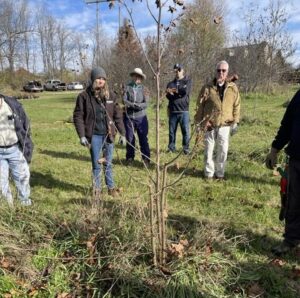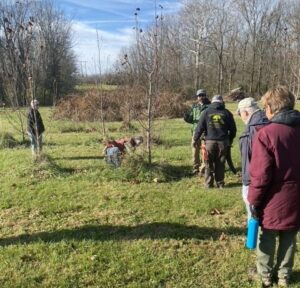Lexington’s tree canopy has just received a boost that bodes well for its future. Trees Lexington!, an organization dedicated to promote the planting and care of trees in the city, conducted its second Tree Steward training program. On two Saturday mornings in November, 15 volunteers learned how to properly plant small bare root trees and to prune others that had grown a bit. The workshops were held at Martin Luther King Park on the North Side, and at Fields to Forest Tree Nursery owned by Wild Ones member Ann Whitney Garner. Taught by Stacey Borden and Wild Ones member Dave Leonard the two sessions were immensely instructive and very enjoyable. The volunteer trainees ditched in with shovels, pruners and tons of questions. It seems obvious that planting trees in Lexington’s parks, greenspaces and private properties – both residential and commercial – is crucial to increasing the city’s tree canopy. The Tree Stewardship program aims to develop a group of tree advocates who can see newly planted trees through their first years of growth and assure that they will become healthy good looking plants that last for a long time.

Often, when home owners envisions a new tree on their property, they end up with a specimen whose heavily truncated roots are contained in a very heavy root ball surrounded by burlap and possibly a wire cage. Due to its weight the tree must be planted by professionals which adds to its already high cost. Once in the ground at its new location, the tree will, for several years, put most of its energy into regrowing the roots that were cut off when it was dug up for transport, usually way over 50% of all its small feeder roots with which it absorbs moisture and nutrients. By contrast, a small bare-root tree (let’s say 4-5’ tall) planted in a proper-size hole, will produce significant top growth during its first season. Five years later its canopy will equal the size a ball-and-burlap tree planted at the same time. Best of all, anybody can plant a bare-root tree; no professionals are needed. And even better, small trees are inexpensive and Trees Lexington! periodically provides them free to homeowners.

But there is more to getting an urban tree off to a good start in its permanent location. Judicious and periodic pruning early in its life helps it develop a good structure, supports its health and assures that it lives well in its designated space. Pruning is a science and an art, workshop participants learned. Science-based rules apply pretty universally: don’t cut off more than 30% of a tree’s crown in a growing season; prune out deadwood; never leave stumps etc. The art comes in when the pruner must envision what the tree will look like when grown up, and there are choices to be made: how high up on the trunk should the tree eventually branch out; does one aim for a densely leafed crown or a more airy one? The Tree Steward workshops developed by Trees Lexington! are a great service to our community. Trained Tree Stewards can advocate for trees in the city, but they can do much more: they can lead volunteer groups in planting trees in public spaces, and they can advise home owners on getting trees started on their properties at minimal cost and then help them guide their trees through the first years. The workshops will be offered periodically for anybody who cares about Lexington’s tree canopy and wants to help improve it. In the meantime, check out Trees Lexington!’s terrific website.
Beate Popkin
